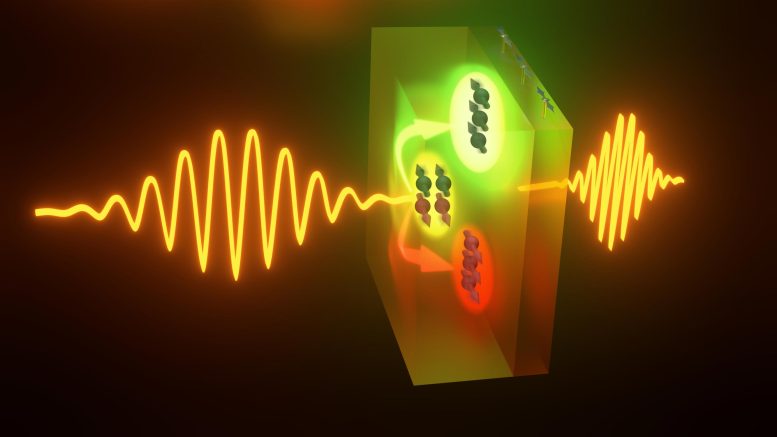
Scientists have unlocked a way to read magnetic orientation at record-breaking speeds using terahertz radiation.
Modern hard drives can store several million megabytes – enough for hundreds of thousands of photos. These high-capacity devices rely on tiny magnetic structures to store data. However, with data transfer rates limited to a few hundred megabytes per second, accessing this information remains relatively slow.
Recent experiments have explored a promising new approach: reading magnetic states using short current pulses. Advances in spintronics – where electron spin is used to manipulate magnetic properties – suggest that specially designed materials could overcome previous speed limitations.
Now, researchers at the Helmholtz-Zentrum Dresden-Rossendorf (HZDR) and TU Dortmund University have demonstrated a breakthrough. Instead of electrical pulses, they use ultrafast terahertz light pulses to read magnetic structures within picoseconds – trillionths of a second. Their findings, published in Nature Communications, confirm the feasibility of this technique, potentially paving the way for ultrafast data storage and retrieval.
Unlocking Magnetic Secrets with Light
“We now can determine the magnetic orientation of a material much quicker with light-induced current pulses,” explains Dr. Jan-Christoph Deinert of HZDR’s Institute of Radiation Physics. His team’s experiments relied on terahertz radiation–light that is invisible to the human eye. With a wavelength of just under a millimeter, terahertz light sits between infrared and microwave radiation on the electromagnetic spectrum. To generate these ultrashort and intense terahertz pulses, the researchers used the ELBE radiation source at HZDR. These pulses proved ideal for analyzing the magnetization of ultra-thin material samples.
The samples consisted of two stacked layers, each only a few nanometers thick. The lower layer was made of a magnetic material, such as cobalt or an iron-nickel alloy, while the upper layer was composed of metals like platinum, tantalum, or tungsten. None of the metal layers exceeded three nanometers in thickness. “The material can only be penetrated by part of the terahertz radiation when the layers are this thin,” Deinert explains. Such partial transparency is a crucial prerequisite for being able to read the magnetization of the lower layer.
Simple Material, Complex Mechanism
“In our experiments, the terahertz flashes generate a variety of interactions between light and matter,” describes Dr. Ruslan Salikhov from HZDR’s Institute of Ion Beam Physics and Materials Research, who was responsible for growing the sample films. In combination with other short-pulse optical lasers, the team managed to visualize and decode the very fast relativistic quantum effects in the wafer-thin layers. First, the terahertz pulses, through their electric field, generate extremely short-lived electric currents in the upper metal layer. Remarkably, the electrons arrange themselves according to the orientation of their intrinsic angular momentum, the spin, creating a spin current that flows perpendicular to the layers. At the interface between the layers, electrons with a specific spin orientation accumulate in quick succession. Depending on the alignment of these spins and the magnetization direction of the lower layer, the electrical resistance of the interface changes. The researchers call this effect unidirectional spin Hall magnetoresistance or USMR, for short.
The USMR effect was discovered some years ago by researchers at ETH Zurich, but the team at HZDR and TU Dortmund University has now made significant advancements. Thanks to this effect, the researchers can read out the magnetization direction very fast using extremely short terahertz pulses. They ensure that the spin current changes direction a trillion times per second. In addition, thanks to the USMR effect, the electrical resistance of the interface varies ultrafast, as well. Consequently, the quantum effect causes a reaction in the terahertz radiation itself.
Harnessing Ultrahigh-Speed Magnetization
“Depending on the direction of magnetization, we generate fast fluctuations in the transparency of the sample,” says Dr. Sergey Kovalev from TU Dortmund University. This alters the terahertz pulses in a very specific way. After penetrating the sample, they oscillate at twice the frequency of the original terahertz radiation – known as the “second harmonic” frequency. “We can detect this oscillation precisely and thus determine the magnetization of the lower layer within picoseconds,” Kovalev summarizes.
Towards Ultrafast Magnetic Memory
Work is already underway not only for reading out but also for writing the magnetically stored data using terahertz radiation. However, the team recognizes that transforming this basic research achievement into an ultrafast hard drive may take considerable time. It would require far more compact sources for short terahertz pulses as well as efficient sensors for analyzing them. Nonetheless, the ultrafast USMR effect highlights the complex mechanisms within relatively simple material systems that can play a significant role in the future development of ultrafast magnetic memory applications.
Reference: “Ultrafast unidirectional spin Hall magnetoresistance driven by terahertz light field” by Ruslan Salikhov, Igor Ilyakov, Anneke Reinold, Jan-Christoph Deinert, Thales V. A. G. de Oliveira, Alexey Ponomaryov, Gulloo Lal Prajapati, Patrick Pilch, Ahmed Ghalgaoui, Max Koch, Jürgen Fassbender, Jürgen Lindner, Zhe Wang and Sergey Kovalev, 6 March 2025, Nature Communications.
DOI: 10.1038/s41467-025-57432-2
Never miss a breakthrough: Join the SciTechDaily newsletter.